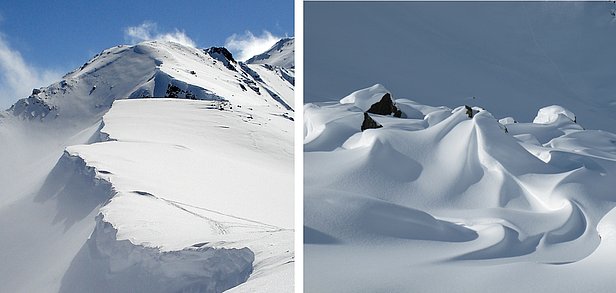
Schneedecke ¶
Ohne Schneedecke keine Lawine. Aber ohne Schneedecke auch keine Unterlage für Pulverschneeabfahrten, kein Kälteschutz für Fauna und Flora, keine kühlende Rückkopplung zur Atmosphäre. Diese Aufzählung liesse sich beliebig fortsetzen und zeigt, welch wichtige Rolle die Schneedecke für den Menschen und die Natur spielt.
Die Schneedecke besteht wie eine Crèmeschnitte aus Schichten. Mit jedem Schneefall kommt eine Lage hinzu. Von den ältesten Schichten am Boden bis zu den jüngsten an der Oberfläche erzählt sie so die Geschichte des Winters. Einige Schichten sind so auffällig, dass wir sie noch Wochen später bestimmten Wetterereignissen zuordnen können, z.B. eine dicke Schmelzkruste nach einem Wärmeeinbruch. Schwache Schichten wie eingeschneiter Oberflächenreif können für erhöhte Lawinengefahr verantwortlich sein. Deshalb wird ihre Entwicklung von den SLF-Beobachterinnen und -beobachtern aufmerksam verfolgt. Um die Vorhersage der Lawinengefahr zu verbessern arbeiten wir daran, den Aufbau der Schneedecke und die Vorgänge, die sich in ihr abspielen, besser zu verstehen und nachzubilden.
Wandelbare Schneedecke
Die Schneedecke ist eine echte Verwandlungskünstlerin: Einmal sinkt man hüfttief ein, das andere Mal bleibt man auf ihr stehen, ohne einzubrechen. Dies sind die Folgen andauernder Veränderungen in der Schneedecke selbst, die von aussen meist verborgen bleiben. Besonders grossen Einfluss auf die Veränderungen hat die Temperatur. Je wärmer der Schnee und je grösser die Temperaturunterschiede zwischen Schneeoberfläche und Boden, umso schneller verändern sich auch die Schneeschichten.
Auch der Wind prägt die Schneeoberfläche (Abb. 1). Er verfrachtet die Schneekörner und schmirgelt sie ab. Er formt harte Windkrusten. Er bläst den Schnee von Kuppen und Rücken, füllt Mulden und Rinnen auf und kann dabei Verkehrswege unpassierbar machen.

Die Grundlagen der Schneeverfrachtung untersuchen wir im Detail im Windkanal des SLF und in Versuchsgeländen. Die Messergebnisse fliessen in Computermodelle ein, welche die Eigenschaften der Schneedecke simulieren.
Strahlung
Die besonderen physikalischen Eigenschaften des Schnees spielen auch für die Schneedecke eine wichtige Rolle. Das blendende Weiss einer frischen Schneeoberfläche zeigt es deutlich: Schnee hat eine hohes Rückstrahlungsvermögen (Albedo). Im sichtbaren Bereich werden 80‑90% des einfallenden Sonnenlichts in die Atmosphäre zurück reflektiert. Zum Vergleich: bei einem Nadelwald sind es 20-50%, bei einer ruhigen Wasserfläche nur 5-25%. Das bedeutet, dass Schnee im Vergleich zu anderen Oberflächen nur einen kleinen Bruchteil der Sonnenenergie aufnimmt. Die Energie, welche trotzdem noch in den Schnee eindringt, beeinflusst dort die Schneemetamorphose.